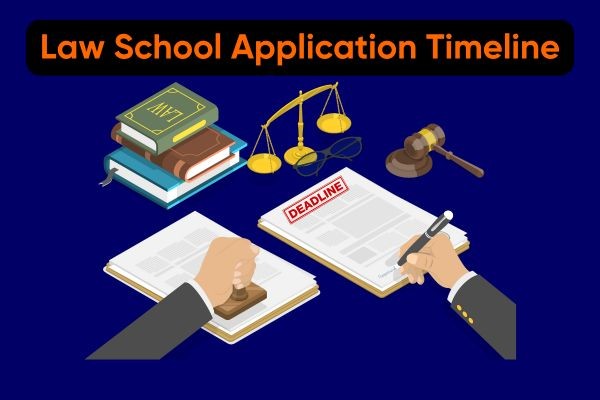The law school application timeline doesn’t have to be confusing or stressful. In this guide, I walk you through what to do each month, how to stay organized, and what to avoid. Also check out how to get into law school and what's on the LSAT guides to keep your plans on track.
Want us to help you? Applicants and students, book a free strategy call here. Universities, businesses, or student organizations representative, book a free call here.
What Is a Law School Application Timeline?
A law school application timeline is your personal roadmap to getting everything done — from LSAT prep to final submission — without scrambling. It’s not about being rigid or robotic. It’s about giving yourself the space to work steadily, make thoughtful choices, and submit a polished application early. And when it comes to law school, early really does matter.
Why the Timeline Matters
If you’ve ever thought “I’ll just figure it out as I go,” that’s a fast track to stress. Most law schools operate on rolling admissions, which means they don’t wait until the deadline to start reviewing files. Seats — and scholarships — are handed out as applications come in. A well-timed application isn’t just on time; it’s ahead of the curve.
But more than that, spacing out your prep lets you actually do your best work. Personal statements take multiple drafts. LSAT prep takes months. And recommendation letters? Those rely on someone else’s schedule, not yours. A timeline helps you juggle it all without dropping the ball.
LSAT Prep and School Research: January to March
This is where it begins. Your focus here is twofold: building your LSAT foundation and understanding your law school options. Start by registering for the LSAT — ideally, aim for the June test if you’re planning to apply in the fall. Then take a diagnostic test to figure out your baseline. It’s not about scoring high yet; it’s about seeing where you are.
Once you have that baseline, create a study plan. Most students need at least 3 to 6 months of focused prep to hit their target score. Whether you self-study, join a course, or hire a tutor, be consistent. Practice LSAT problems, reasoning sections, and timed tests — not just one at a time, but full-length exams to build endurance.
Meanwhile, start looking into law schools. Use LSAC’s Official Guide, check out school websites, and read ABA-required disclosures on employment and bar passage. At this stage, cast a wide net. It’s fine to list 15–20 schools — you’ll narrow it later.
Finalizing Your School List and First Drafts: April to June
Once you have a few months of LSAT prep under your belt, you’ll have a better sense of your potential score range — and what schools are within reach based on law school acceptance rates. Around this time, you’ll also want to narrow your list to about 10–12 programs. Make sure you have a mix: a few reach schools, several matches, and a couple of safeties based on GPA and LSAT data.
This is also when you should start writing. Your personal statement isn’t something you knock out in an afternoon. Give yourself time to brainstorm, draft, and edit — then do it again. A good first draft is one thing. A compelling, polished essay takes rounds of revision, usually over a few weeks.
Start reaching out to your potential recommenders too. Professors and employers appreciate advanced notice, and they’ll write better letters if they’re not rushed. Let them know your goals and why you’re applying, and offer to provide your resume and statement draft for context.
Building Your Application Package: July to September
By mid-summer, your application materials should be taking shape. Ideally, you’ve taken your LSAT already — or you’re planning a retake. If you’re happy with your score, shift gears to your supporting documents.
Now’s the time to finalize your personal statement. Ask a few trusted people — not just friends, but those who will give you honest feedback — to read your draft. Review your resume too. Law school resumes aren’t like job resumes; they’re academic-focused and emphasize writing, leadership, service, and analytical experience.
If a school allows (or requires) additional essays like a diversity statement or “Why This School” essay, start those now. These aren’t optional for competitive applicants. They’re opportunities to show fit, insight, and awareness of the school’s mission.
Finally, request your transcripts and make sure your letters of recommendation have been submitted. You should also begin inputting information into the LSAC Credential Assembly Service or whichever platform your schools use. Don’t wait for perfection to start this step — the more you can do now, the smoother the submission process will be.
Submission and Final Touches: October to December
Your goal should be to submit all applications by mid-October if possible, especially for schools with rolling admissions. Some schools have hard deadlines as late as February or even June, but applying earlier almost always works in your favor.
Before hitting “submit,” triple-check every component: your statement, resume, letters, transcripts, and each school’s specific requirements. Is there a supplemental essay? A video response? A page limit on resumes? Missing small things can lead to big delays.
After submission, track everything. Create a spreadsheet or use a law school application tracker tool. Confirm that your CAS report was received and that your schools mark your file as complete. And start prepping for potential interviews — some schools invite applicants for virtual or in-person conversations as part of their holistic review.
How to Choose Which Law Schools to Apply To
Not sure which law school to apply to? There’s no one right list of schools. But there is a right list for you.
Start by asking: where do I want to practice? Most law grads work in the same state where they went to school. Look into bar passage rates, employment outcomes, and cost of attendance. Check if schools offer strong clinics or externships in your areas of interest — public interest, corporate law, immigration, etc.
Pay attention to things like school culture and teaching philosophy. Some schools are known for their collegial environment. Others use a rigorous Socratic method that may not suit everyone. Reach out to alumni or current students if you can, and don’t choose based on rankings alone.
Personal Statement Advice That Actually Helps
The best law school personal statements are honest, specific, and reflective. They don’t try to impress with legal jargon or dramatic origin stories. Instead, they show how your experiences, values, and goals connect to the decision to pursue law.
A useful structure might include a personal anecdote or challenge, what you learned from it, and how it shaped your desire to enter the field. Avoid repeating your resume. Don’t try to name-drop every class a school offers. Just focus on showing who you are and why you’ll thrive there.
Addenda and Supplemental Essays
Sometimes, you need to explain something in your application. That’s what an addendum is for — not to make excuses, but to provide context. If you had a low GPA one semester due to personal issues, or if you took the LSAT multiple times and improved, that’s worth a short, factual note.
Supplemental essays are your chance to go beyond the standard application. Schools that ask “Why this school?” want to see that you’ve done your research. Mention specific clinics, values, or teaching methods that resonate with you — not just location or prestige.
Letters of Recommendation: Getting Them Right
Choose your recommenders carefully. Ideally, you want one or two professors who can speak to your analytical thinking and writing skills. A supervisor can also be helpful if your work is relevant to law or shows responsibility, leadership, or ethics.
Make the process easy for them. Send your resume, explain your goals, and remind them of your deadlines. Follow up — respectfully — a week or two before letters are due if they haven’t been submitted.
Financial Aid and Scholarship Tips
Don’t wait until after you’re admitted to think about money. Some schools automatically consider you for merit scholarships if you apply early. Others require additional forms or separate essays.
Fill out the FAFSA (or your country’s equivalent) as soon as it opens. It’s free, and even if you don’t expect need-based aid, some scholarships require it. Look into external funding too: bar associations, nonprofits, and identity-based organizations all offer support.
And start budgeting now. Law school costs vary widely — from $20K to $80K per year — and that’s just tuition. Knowing your options early helps you make smarter decisions later.
What If You’re Reapplying?
If this isn’t your first application cycle, that’s okay. Admissions offices don’t hold that against you — as long as your new application shows growth.
You should update every part of your materials: essays, resume, even letters if possible. You don’t need to explain why you didn’t get in last year, but if there’s a reason (like a low LSAT score or weak personal statement), consider addressing it in an addendum or rewriting with that in mind.
Common Mistakes to Avoid
One of the biggest mistakes is treating the application like a checklist. Yes, you have to submit certain forms and documents. But admissions officers are looking for more than just boxes ticked. They want to understand who you are, why you’re choosing law, and whether you’ve done your homework.
Other common errors include starting LSAT prep too late, submitting generic personal statements, missing school-specific essay prompts, and assuming recommenders will automatically write strong letters. Each part of your application needs time, intention, and review.
Final Thoughts
Applying to law school is a major project — but it doesn’t have to be chaotic. A strong timeline helps you manage everything without burning out. Instead of rushing, you’re able to reflect, revise, and submit your best work.
You’ve got time. You’ve got tools. And now, you’ve got a plan
FAQs
1. When should I start preparing for law school applications?
Ideally 12–18 months before you plan to start school.
2. When do law school applications open?
Most open in early September.
3. What’s the best month to apply?
October or early November is optimal for rolling admissions.
4. How long does LSAT prep take?
Three to six months is average for solid improvement.
5. Do I need to write a diversity statement?
Only if you have a meaningful story or identity-related experience to share.
6. Should I apply to schools I’ve never visited?
Yes — just do your research. Campus visits are helpful but not required.
7. How many schools should I apply to?
About 8–12, including reach, match, and safety schools.
8. Can I reuse my personal statement?
You can reuse your main draft but tailor it for school-specific prompts.


Have a question? Ask our admissions experts below and we'll answer your questions!
Anything we didn't cover? Have a question? Ask below or share your comments!
Comments